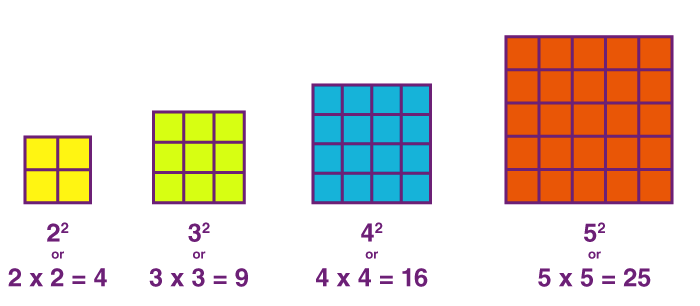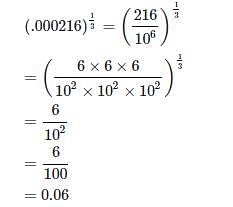Squares, Square Roots, Cubes, Cube Roots | Quantitative Techniques for CLAT PDF Download
Understanding the concepts of squares, square roots, cubes, and cube roots is crucial for various mathematical problems, and it's a fundamental aspect of quantitative aptitude tested in exams like CLAT (Common Law Admission Test).
SQUARES, SQUARE ROOTS, CUBES, CUBE ROOTS
Squares: When the exponent of a base is 2, the numbers obtained are called squares or squared numbers.
Perfect Square: A natural number is called a perfect square if it is the square of a number.
1, 4, 9, 16, 25, 36 --------- are the perfect square of the numbers
1, 2, 3, 4, 5, 6 ------------ respectively.
5, 6, 7, 8, 11, 50, and 125 are not perfect squares of any natural number.
 Examples of Perfect Square
Examples of Perfect Square
To determine whether a given number is a perfect square.
Step I: Express the given number as the product of its prime numbers.
Step II: Express the prime factors as pairs of same number
Step III: Check if there are any unpaired factors
Step IV: If there is no unpaired factor, the given number is a perfect square.
Properties of Squares
1) Squares of even numbers are even.
2) Squares of odd numbers are odd.
3) A number ending with 2, 3, 7, or 8 is never a perfect square. e.g. 23, 347, 2818 cannot be perfect squares.
4) A number ending with an odd number of zeros is never a perfect square. Thus 150, 4400000, and 48000 cannot be perfect squares.
5) The square of a natural number (other than 1) is either a multiple of 3 or exceeds a multiple of 3 by 1.
6) The square of a natural number (other than 1) is either a multiple of 4 or exceeds a multiple of 4 by 1
7) The difference between the squares of two consecutive natural numbers is equal to their sum.
For example: 22 - 12 = 4 – 1 = 3 which is equal to 2 + 1 = 3
52 - 42 = 25 – 16 = 9 which is equal to 5 + 4 = 9
112 - 102 = 121 – 100 = 21 which is equal to 11 + 10 = 21
Example :- Which of the following is not a perfect square in the options given below?
A. 25
B. 89
C. 100
D. 49
Ans: B) 89
Some interesting facts:
1) Pythagorean Triplets: For every natural number m (other than 1) there is a triplet such as (2m), (m2-1), and (m2+1)
These triplets are called Pythagorean Triplets. They obey the relation (2m)2+(m2-1)2=(m2+1)2
For m = 2, Pythagorean triplets are 2 x 2, 22-1, 22+1 or 4, 3 and 5 and (4)2 + (3)2 = 52
For m = 4, triplets are 4 x 2, 42 - 1, 42 + 1
i.e. 8, 15, 17 and 82 + 152 = 172
and so on it is true for every natural number.
2) The square of any natural number will have either 0, 1, 4, 5, 6, or 9 at the unit place.
3) The square of a natural number (n) is always equal to the sum of the first (n) odd natural numbers.
If x = 4 Then 42 = 1 + 3 + 5 + 7
If x = 6 Then 62 = 1 + 3 + 5 + 7 + 9 + 11
If x = 9 Then 92 = 1 + 3 + 5 + 7 + 9 + 11 + 13 + 15 + 17
4) If n is a perfect square then 2n can never be a perfect square.
5) A perfect square number is never negative.
Square Roots
The square root of a number n is that number which when multiplied by itself gives n as the product. For example 7 x 7 = 49, So 7 is the square root of 49. It is written as 
Finding the square root of a perfect square
(a) By finding prime factors
Example 1: If the square root of 576 is to be found out we find the prime factors of 576?
Solution: 576 = 2 x 2 x 2 x 2 x 2 x 2 x 3 x 3
Make pairs of factors and pick up one factor from each pair.
= 2 x 2 x 2 x 3 = 24
Example 2: Simplify 
Solution: 900 = 30 x 30
0.09 = 0.3 x 0.3
= 0.3
0.003
= 30.303
(b) Finding the square root by long division method
Example 1: Find the square root of 7396
Solution:

Step I: Beginning from the right, reduce the digits in pairs from right to left.
Step II: Take the first pair of digits and find the nearest sq. root. The nearest square root of 73 is 8. Write 8 as quotient and also as divisor. Write the product 8 x 8 = 6 below 73 and Subtract.
The remainder is 9
Step III: Bring down the next pair 96. Double 8, the number in the quotient and place the double i.e. 16 as the next divisor. Now 99 divided by 16 is approximately 6. So put 6 with 8 in the quotient also with 16 as the divisor and multiply 166 by 6 and get 996. Now the remainder is zero. So 86 is the exact square root.
Therefore
Example 2: Find the sq. root of 
Solution:
Finding the number of digits in the square root of a perfect square.
Rule
If a perfect square contains n digits then, its square root will contain
digits if n is even and
digits if n is odd.
 is equal to
is equal to
Finding the Square Root of a Perfect Square Decimal Number by Long Division.
While finding the square root of a natural number we make pairs from right to left and if in the last, one digit is left, we leave it by itself. In case of decimal number we make pairs from right to left for the integral part and from left to right for the decimal portion.
If the last period of the decimal number contains only one digit, we add zero to it. The square root of a decimal number will contain as many decimal places as there are pairs in the decimal part of the given number. The method to be followed is the same as for the whole number.
Example 1: If  = 56. Find the value of
= 56. Find the value of  +
+ 
Solution: Since
= 56
= 5.6
and
= 0.56
∴
+
.= 5.6 + 0.56 = 6.16
Example 2: Find the value of

If 
Solution:

Example 3: Evaluate 
Solution: Given expression =
Example 4: Evaluate 
Solution: The sum of decimal places both in the numerator as well as denominator is 6. So we can remove the decimals
Example 7: Find the least number which must be added to 4562 to make it a perfect square.
Solution:

8 x 128 = 1024
If in place of 962 it is 1024 we will get a perfect square so add
1024 – 962 = 62
Cubes
A cube of a number, is that number raised to the power 3. The cube of a number is obtained by multiplying it with itself 3 times.

Cube of 5 is 5 x 5 x 5 = 125
Cube of 6 is 6 x 6 x 6 = 216
How to determine whether a given number is a perfect cube
Step 1: Make prime factors of the given number
Step 2: Make groups of the prime factors – a group containing 3 same numbers.
Step 3: Check the ungrouped factor
Step 4: If there is no ungrouped factor, the number is a perfect cube.
 Perfect Cube Example
Perfect Cube Example
Example: Is 1728 a perfect cube
Solution: Prime factors of 1728 are = 2 x 2 x 2 x 2 x 2 x 2 x 3 x 3 x 3
The prime factors can clearly be grouped into groups of 3 each and no factor is left ungrouped
So 1728 is a perfect cube.
Properties of cubes:
(i) Cube of a natural number is a natural number
(ii) Cube of all even natural numbers are even.
(iii) Cube of all odd natural numbers are odd.
(iv) Cubes of all negative numbers are negative.
(v) For any rational number 
(vi) Cube of a natural number, which is a multiple of 3, is a multiple of 27
(vii) Cube of a natural number of the form 3n+1 is also a natural number of the form 3n+1
(viii) Cube of a natural number of the form 3n+2 is also a natural number of the form 3n+2
(ix) Cube of a number, having a zero at the unit place, has three zeros at the end.
For example (10)3 = 1000
Example: What is the smallest number by which 2400 be multiplied so that the product is a perfect cube?
a) 70 b) 80 c) 90 d) 60
Solution: 2400 = 2 x 2 x 2 x 2 x 2 x 3 x 5 x 5
After making the groups of three for each prime number we need one 2’s, two 3’s and one 5.
So we need a number 2 x 3 x 3 x 5 i.e. 90
So option (c) is correct.
Cube roots
A natural number n is a cube root of the number m if m = n3
The symbol for cube root is 
To find the cube root of a perfect cube number
Step 1: Make prime factors of the given number
Step 2: Make groups of three each of the prime factors
Step 3: Choose one out of the group of three factors and find their product
Step 4: This product is the required cube root of the given number.
Example: Find the cube root of -4096
Solution: Prime factors of 4096 are 2 x 2 x 2 x 2 x 2 x 2 x 2 x 2 x 2 x 2 x 2 x 2
|
56 videos|104 docs|95 tests
|
FAQs on Squares, Square Roots, Cubes, Cube Roots - Quantitative Techniques for CLAT
| 1. How do I determine whether a given number is a perfect square? |  |
| 2. How can I find the square root of a perfect square? |  |
| 3. How can I find the number of digits in the square root of a perfect square? |  |
| 4. How can I find the square root of a perfect square decimal number by long division? |  |
| 5. How can I determine whether a given number is a perfect cube? |  |

|
Explore Courses for CLAT exam
|

|
















